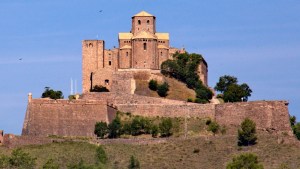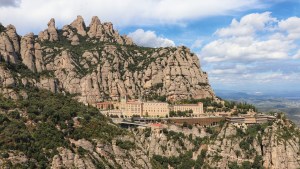Lenten Campaign 2025
This content is free of charge, as are all our articles.
Support us with a donation that is tax-deductible and enable us to continue to reach millions of readers.
The Monastery of Santa Maria de Ripoll is located in the peaceful town of Ripoll in Catalonia, Spain. It’s a great example of centuries of monastic tradition, architectural splendor, and cultural heritage. This Benedictine monastery, originally founded in 888 (some say 879) by Count Wilfred the Hairy, has seen history unfold. As is the case with most of these Romanesque buildings, the monastery has been through plenty of reconstruction and restoration – all of which have added to its history.
Count Wilfred the Hairy, known as Guifré el Pilós in the original Catalan, set up the monastery to repopulate the region after it was reconquered. His vision paid off, and the monastery grew quickly, becoming a center for learning and spirituality. Indeed, some consider this monastery the cradle of Catalonia. Wilfred’s son, Ridulph, was educated here, and later became the abbot of the monastery – and the bishop of the important see of Urgell.
The monastery’s influence soon spread far beyond Ripoll, leading to the establishment of affiliated abbeys like St. Martin-du-Canigou in France and the famed Santa Maria de Montserrat. By 1046, the library had already amassed a remarkable collection of 246 manuscripts, which grew to include the 13th-century Gesta Comitum Barcinonensium – the first written history of Catalonia, penned by the monks.

The church has a beautiful, grand Romanesque architectural style, though it was mostly rebuilt in the 19th century. The original church had a nave and four aisles with barrel vaults, and five apses (later expanded to seven). The 1896 reconstruction by architect Elias Rogent kept the church’s Romanesque character while making it more modern. The current church, with its two aisles, houses the tombs of the Counts of Besalú and several Counts of Barcelona, including Wilfred the Hairy and Ramón Berenguer IV.
The cloister and portico
The lower floor of the cloister still has many original elements dating from 1180 to the early 15th century. The upper floor was built later, in the 15th and 16th centuries, and is profusely decorated with semicircular arches, supported by paired columns with intricately carved Corinthian-style capitals. These capitals, created by artists Pere Gregori and Jordi de Déu, feature scenes from both classical mythology and daily life, showing off the artisans’ craftsmanship.

But one of the most striking features of Santa Maria de Ripoll is surely its sculpted portico – a true masterpiece of Iberian Romanesque art. Despite some damage over the centuries, the portico is still impressive. The mid-13th-century relief is divided into seven horizontal bands, showing scenes from the Bible and mythological stories and creatures. The portico, flanked by statues of St. Peter and St. Paul, serves as a grand entrance, inviting visitors in.
A living heritage
Today, the Monastery of Santa Maria de Ripoll continues to impress with its blend of historical significance, religious relevance, and architectural beauty. It is a classic place of pilgrimage for locals, and tourists often visit it to get a peek into the past. But the monastery is not just some medieval relic: it is still standing as a beacon of faith and resilience.



